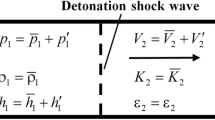Abstract
Laminar boundary layer flows behind constant speed shock waves moving into a dusty gas are analyzed numerically. The basic equations of two-phase flows are derived in shock fixed coordinates and solved by an implicit finite-difference method for the side wall boundary layer in a dusty gas shock tube. The development of the boundary layer and resulting velocity and temperature profiles, respectively, for the gas and particles are given from the shock front to far downstream. The effects of diaphragm pressure ratio, mass loading ratio of particles and particle size upon the flow properties are discussed in detail.
Similar content being viewed by others
References
Barron RM, Wiley JT (1981) Newtonian flow theory for slender bodies in a dusty gas. J Fluid Mech 108:147–157
Chang SSH (1975) Nonequilibrium phenomena in dusty supersonic flow past blunt bodies of revolution. Phys Fluids 18:446–452
Chapman S, Cowling TG (1961) The mathematical theory of non-uniform gases. Cambridge University Press, London
Coakley TT, Champney JM (1985) Numerical simulation of compressible turbulent two-phase flow. AIAA Paper 85–1666
Crowe CT (1982) Review-numerical models for dilute gas-particle flow. ASME J Fluid Eng 104:297–303
Drew DA (1983) Mathematical modeling of two-phase flow. Ann Rev Fluid Mech 15:261–291
Gilbert M, Davis L, Altman D (1955) Velocity lag of particles in linearly accelerated combustion gases. Jet Prop 25:26–30
Glass II, Hall JG (1959) Handbook of supersonic aerodynamics. NAVORD Rept 6-1488
Hooker WJ, Morsell AL, Watson R (1970) Shock tube studies on two-phase systems. AGARD-CR 38-71
Knudsen JS, Katz DL (1958) Fluid mechanics and heat transfer. McGraw-Hill, New York
Lee SL (1982) Aspects of suspension shear flows. Adv Appl Mech 22:6–65
Marble FF (1970) Dynamics of dusty gases. Ann Rev Fluid Mech 2:397–446
Marconi F, Rudman S, Calia V (1981) Numerical study of one-dimensional unsteady particle laden flows with shocks. AIAA J 19:1294–1301
Mirels H (1971) Boundary layer growth effects in shock tubes. In: Stollery JL, Gaydon AG, Owen PR(eds) Proc 8th Int Shock Tube Symp pp 6/1–6/30
Miura H, Glass II (1982) On a dusty gas shock tube. Proc R Soc London A382:373–388
Miura H, Glass II (1983) On the passage of a shock wave through a dusty gas layer. Proc R Soc London A385:85–105
Miura H, Glass II (1985) Development of the flow induced by a piston moving impulsively in a dusty gas. Proc R Soc London A397:295–309
Otterman B, Levine AS (1974) Analysis of gas-solid particle flows in shock tubes. AIAA J 12:579–580
Outa E, Tajima K, Morii H (1976) Experiments and analyses on shock waves propagating through a gas-particle mixture. Bull JSME 19:384–394
Outa E, Tajima K, Suzuki S (1981) Cross-sectional concentration of particles dring shock process propagation through a gas particle mixture in a shock tube. In: Treanor CE, Hall JG (eds) Proc 13th Int Shock Tube Symp pp 655–663
Rudinger G (1970) Effective drag coefficient for gas-particle flow in shock tubes. J Basic Eng 92:165–172
Rudinger G (1980) Fundamentals of gas-particle flow. Elsivier New York
Singleton RE (1965) The compressible gas-solid particle flow over a semi infinite flat plate. Zeit ange Math Phys 16:421–449
Sommerfeld M and Gronig H (1983) Decay of shock waves in a dusty gas shock tube with different configurations. In: Archer RD, Milton BE (eds) Proc 14th Int Shock Tube Symp, Sydney, pp 470–477
Soo _SL (1967) Fluid dynamics of a multiphase system. Blaisdell Massachussets
Wang BY, Glass II (1986) Laminar sidewall boundary layer in a dusty gas shock tube. UTIAS Rept 312
Wang BY, Glass II (1988) Compressible laminar boundary layer flows of a dusty gas over a semi-infinite flat plate. J Fluid Mech 186:223–441
Author information
Authors and Affiliations
Additional information
This article was processed using Springer-Verlag TEX Shock Waves macro package 1990.
Rights and permissions
About this article
Cite this article
Wang, B.Y., Glass, I.I. Boundary layer flows behind constant speed shock waves moving into a dusty gas. Shock Waves 1, 135–144 (1991). https://doi.org/10.1007/BF01414908
Received:
Accepted:
Issue Date:
DOI: https://doi.org/10.1007/BF01414908




